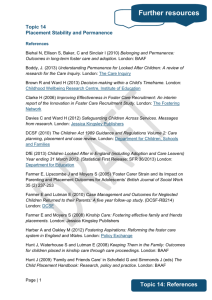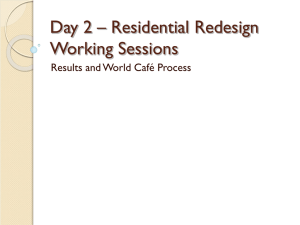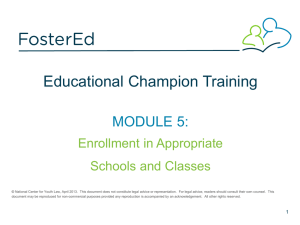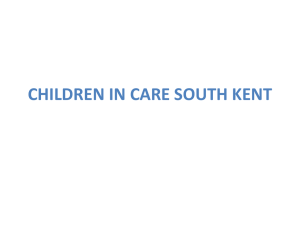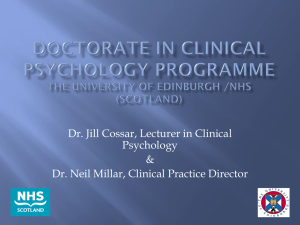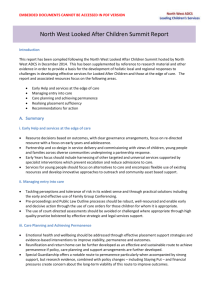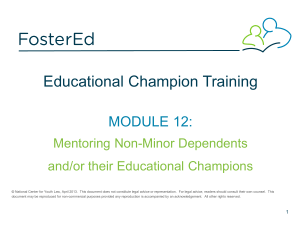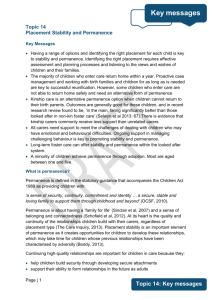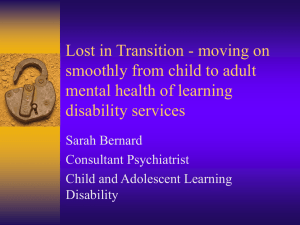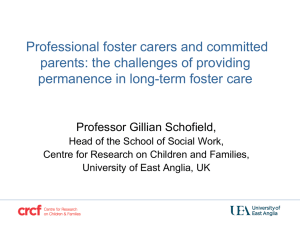Placement Stability & Permanence
advertisement
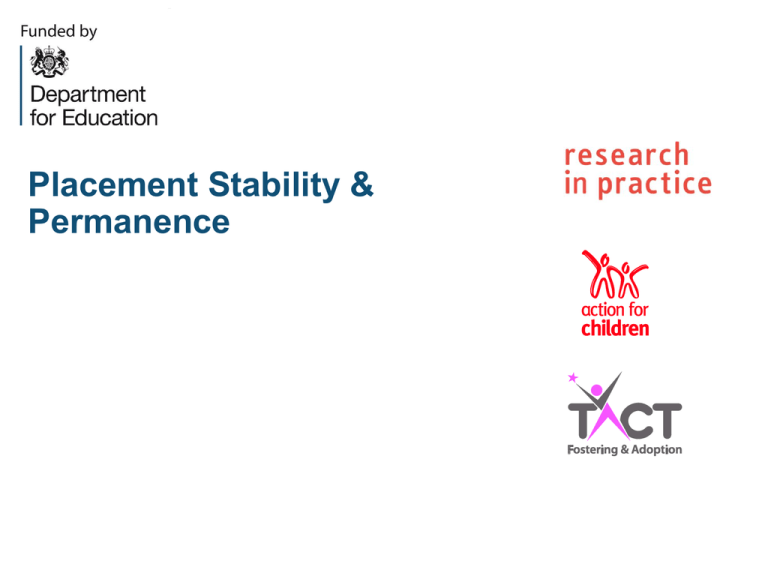
Placement Stability & Permanence What is Permanence 'a sense of security, continuity, commitment and identity ...... a secure, stable and loving family to support them through childhood and beyond'. (Department for Education, 2010, p12) It is about having a 'family for life‘ and a sense of belonging and connectedness Permanence can be reached through different pathways: • • • • return to birth parents shared care arrangements permanence within the looked after system (residential placement, unrelated foster care, family and friends care) legal permanence (adoption, special guardianship, residence orders). Permanence Statistics (1) Many children who become looked after return home quickly and do not need a plan for permanence 70% of foster placements that ceased during the year ending 31 March 2013 were for under one year 35% of those who ceased to be looked after during the year ending 31 March 2013, returned to live with a parent or relative (Department for Education, 2013a) Permanence Statistics (2) In the year ending 31 March 2013, 11% of looked after children had three or more placements Teenagers aged 13-16 years when they become looked after, are the most likely to have three or more placements (Department for Education, 2013) The Impact of Placement Instability Reduces the opportunities for children and young people to develop secure attachments May exacerbate existing behavioural and emotional difficulties Has an impact on education and health care Placement Planning and Support Identifying the right placement for each child is key to stability and permanence Shortage of suitable placements may lead to decisions being put off until there is a crisis - leads to emergency placement and subsequent move Placement planning with older children is less proactive than with younger children Placement Planning and Support Children need to be consulted about their care plan: including children in decision-making can improve the quality of the decisions and lead to more stable placements Support should be a part of all care plans Carers need information about the child in order to prepare for the placement: placements made in a hurry, without consultation and full information are more likely to disrupt Reunification Preferred pathway to permanence is a return to the birth family, but not always safe to do so Many maltreated children who return home do not stay there: around a third of children who return home reenter care (Wade et al, 2011) Around half of those who have been abused or neglected suffer further abuse when they return home (Farmer and Lutman, 2010) Cases often closed within six months, even when there are continuing concerns Reunification It is important that before and after children return home there is: • • • • evidence of improvements in parenting capacity an effective assessment of risk slow and well managed return home provision of services to support children and their families, for as long as is needed (Davies and Ward, 2012) Unrelated foster care Foster care important permanency option Foster care is the most common placement choice: • • 75% of looked after children are in foster care 85% of these children are placed with unrelated foster carers The ‘match’ between child and carer is important for stability, importance of ‘chemistry’ Children living in stable and long-term foster care have similar outcomes to adopted children (Biehal et al, 2010) Stability is undermined if the placement is not supported Foster carers need to feel valued, involved in decisions and be a formal member of the care planning team Kinship care The Children Act 1989, encourages local authorities to place children with a relative, friend or other ‘connected’ person if they are unable to live with their parents Kinship care enhances children's sense of belonging through continuity of family identity Children placed in kinship care generally do as well as children in unrelated foster care Kinship care Kincarers characteristics: grandparents • have few financial resources available • often ill health or disability Despite challenges, often receive little support • Support for kincarers is important as, where carers show signs of strain, placement quality is likely to be of poorer quality Permanence through adoption Around 5% of looked after children achieve permanence through adoption Around three quarters are aged between one and four years (Department for Education, 2013) Delays in the adoption process can reduce children’s chances of being adopted Delays increase the chance of adoption breakdown - age at joining a new family has the most impact on adoption outcomes (Selwyn et al, 2006) Adoption provides much more stability than unrelated foster care, with lower disruption rates, although the rates converge as the child's age at placement increases (Triseliotis, 2002) Videolinks Hear Nina Biehal talking about Four Types of Permanent Placements as part of the Adoption Research Initiative

